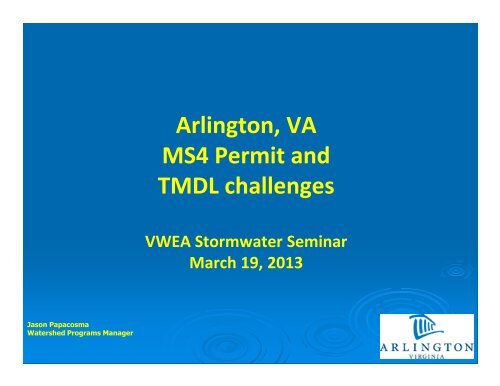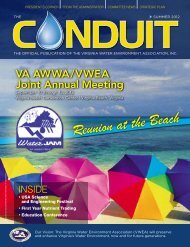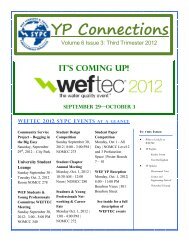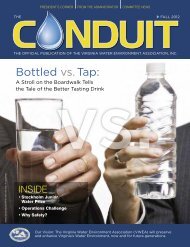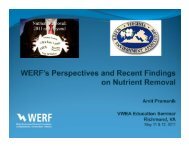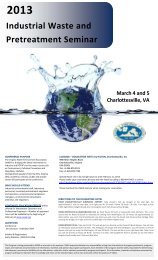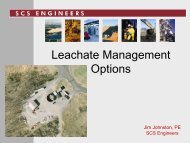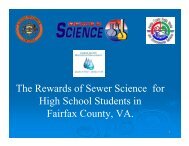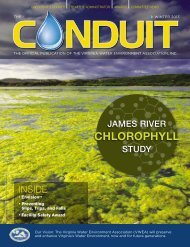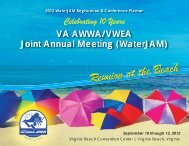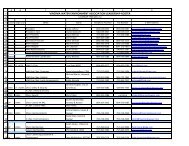Jason Papacosma, Arlington, VA
Jason Papacosma, Arlington, VA
Jason Papacosma, Arlington, VA
Create successful ePaper yourself
Turn your PDF publications into a flip-book with our unique Google optimized e-Paper software.
<strong>Arlington</strong>, <strong>VA</strong>MS4 Permit andTMDL challengesVWEA Stormwater SeminarMarch 19, 2013<strong>Jason</strong> <strong>Papacosma</strong>Watershed Programs Manager
<strong>Arlington</strong> Watershed Facts• 2010 Census: 207,627 people• Phase I jurisdiction• 26 square miles• 7,972 persons/square mile• 42% impervious cover• 400 miles of storm sewers• 28.5 miles of perennial streams• Potomac River watershed
2008 – established dedicated funding source forstormwater infrastructure and water quality Completed County-wide watershed retrofit and streamcorridor assessments Awarded contract for comprehensive consultant support Added 1 FTEPlanning ahead Signficant project and program accomplishments inadvance of new permit – stream restoration, retrofits,street sweeping, homeowner incentive program, etc. Next permit cycle (with 35% load reductions) will requiremore funding and personnel3
2012 3/12: Pre-draft 7/31: DCR sends draft to EPA for 30 day review 8/30: EPA notifies DCR – 60 additional days review 10/29: EPA provides DCR ‘official’ comments 11/20: DCR provides response to EPA comments 12/19: EPA provides ‘response to DCR response’2013 1/4: More EPA comments 1/22: DCR responseMS4 Permit Status 2/6: EPA, DCR, <strong>Arlington</strong> conference call to resolve outfall repairrequirements 2/10: Draft permit released for public comment 3/22: Public hearing; 3/29: Comment deadline 4
Why this MS4 Permit is different Chesapeake Bay TMDL pollutant load reductions Local TMDL action plans Performance measures More training More inspections More analysis, modeling, monitoring More emphasis on ‘enforceability’5
Key permit provisions from our perspective Clear compliance standardCompliance with the requirements of this permit shall constituteadequate progress toward…TMDL WLAs and WQS. TMDL action plans focused on quantifying pollutant reductions(complex but doable) rather than demonstrating water qualityimprovement (very complex, takes time to evaluate trends, etc.) ‘Clean‘ 5-year permit Performance measures that track with local priority programs6
Chesapeake Bay TMDL& <strong>Arlington</strong> MS4 permitPollutant load reductions from 2009baseline:Nitrogen -8%Phosphorus -14%Sediment -18%Required load reduction schedule:Permit cycle #1 (2013 – 2017) 5%Permit cycle #2 (2018 – 2022) 35%Permit cycle #3 (2023 – 2027) 60%
Meeting Bay TMDL Load ReductionsTwo ScenariosPortion of target load reductions by BMP type (TP)RedevelopmentStreet sweeping06-09 BMPs16 miles56% stream milesRedevelopment06-09 BMPsStreamrestorationBallston PondStreetscaperetrofitsBeaver PondStreet sweeping200 acres5,000 acres27% land area65% impervious area5 milesStreamrestorationStreetscaperetrofitsScenario 1:Existing Bay Program credits for streamrestorationScenario 2:CSN interim credits for stream restoration
Costs Scenario 1: Estimated costs in the $500 million range by2027 Scenario 2: Estimated costs in the $50 million range by2027 Projected funding through dedicatedStormwater Fund through 2027 ~$25 million.Retrofits@ $100,000/acreStream restoration@$700/lf
Key Points Retrofit levels needed under Scenario 1 exceed masterplan-identified potential and not feasible by 2027 Stream restoration credit level very importantCSN proposed interim credits make stream restoration themost ‘productive’ urban BMP – by a large marginPredict final credit will be lower – and harder to claim? Throughput limitations for delivering retrofits and streamrestoration a strong reality Redevelopment reductions will help but only a little overthis relatively short timeframe
Interim strategy Use surplus N and P credits from <strong>Arlington</strong>’sPOTW to achieve compliance Gain time (30+years) to implement retrofitsand stream restoration projects Will not cover sediment reductions or addresslocal TMDLs
Challenges moving ahead Can consensus be achieved among EPA, DCR,MS4s, and advocacy community? Will the ‘perfect’ be the enemy of the ‘good?’ Are the 35% and 60% reductions achievable by2027? Is the public really on board for scale, type, andcost of infrastructure re-construction needed?12
The ‘ideal’ permit? Ambitious permits to push local programs farther Recognition that stormwater cannot be managed like atrue point source Regulatory/advocacy community desire for‘enforceability’ MS4 permittee desire for ‘compliance’ Reality of long timeframes for local implementation Sound use of limited resources Common desire for local and regional watershedimprovements Recognition of limits of urban watershed restoration13
Questions?www.arlingtonva.usSearch ‘stormwater’14


